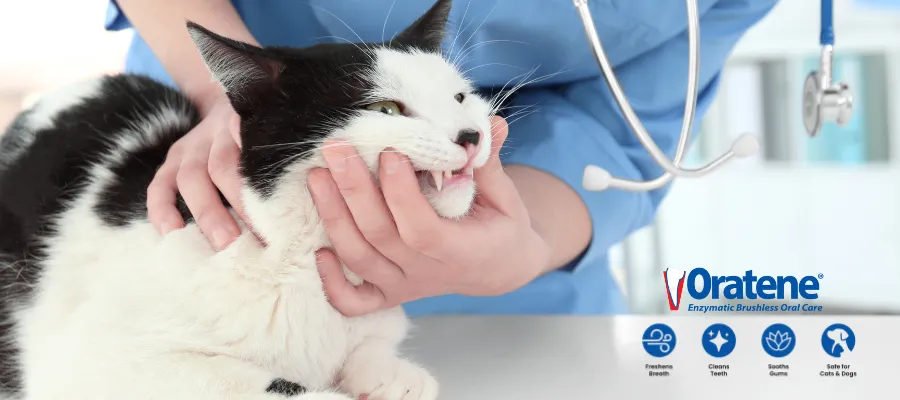Cat Breeds Prone to Dental Issues: Causes, Prevention, and Care
Posted - February 1, 2025

By Carol Bryant, Professional Pet Blogger
Oral health is a critical and often overlooked part of caring for a cat’s well-being. Like dogs, cats of all breeds and ages can develop oral health problems. Though there are select cat breeds prone to dental issues, there are preventative measures pet parents can take to keep feline oral issues under control.
Taking care of your cat’s teeth and mouth is critical. With over 42.2 million U.S. households owning at least one cat, one can imagine how many teeth are at risk.
In this article, we’ll explore the cat breeds prone to dental issues, dive into the causes, and offer easy tips pet parents can implement from home.
Cat Breeds Prone to Dental Issues
Periodontal disease is the most commonly diagnosed dental disease in cats, which causes inflammation of the gums and pain. Fortunately, early-stage gingivitis can be reversed with proper oral care. However, when gingivitis (inflammation of the gums surrounding teeth) goes untreated, it can be difficult to resolve, with eventual teeth loss.
Whether you have one of the cats prone to dental issues or not, all felines should have ongoing regular in-home and veterinary dental care and check-ups.
Cats most prone to dental problems include:
- Persian cats: Flatter faces, shortened jaw structure, and smaller mouth size lead to food trapping and buildup of food.
- Siamese cats: Prone to certain oral lesions called feline odontoclastic resorptive lesions (FORLs), underbite, or overbite.
- Maine Coon cats: More susceptible to gum disease due to genetics.
- Abyssinian cats: Due to genetics, this feline breed has sensitive gums and are prone to FORLs.
- British Shorthair cats: The breed tends to retain baby teeth longer, which can lead to crowding or misalignment as adult teeth break through.
- Burmese cats: They tend to have FORLs and a small mouth size, which can lead to food getting trapped and tartar buildup.
Causes of Dental Issues in Cats
In most cases, anatomy or genetics are the two most common reasons certain cat breeds are prone to dental issues.
Anatomy: Breeds with a flat face, such as Himalayans and Persians, more often have structural issues that lead to dental issues.
Genetics: Some breeds are prone to dental concerns due to genetics. This makes them more likely to develop periodontal disease or FOLs.
Diet: If your cat eats a commercial food that is not formulated for dental care, this can lead to oral issues. Most special dental diets have larger kibble pieces and textures or polyphosphates that help bind calcium in saliva. In turn, it prevents plaque from becoming tartar.
Jaw Size: Jaw alignment and size are both important as they influence how teeth function and how they are positioned in the mouth. A small or abnormal jaw may lead to malocclusion, where teeth lack proper alignment.
Lack of Dental Care: Without regular veterinary care and at-home management of teeth and gums, cats can develop harmful bacteria, plaque, and more.
How to Prevent Problems and Care for Cat Teeth
Whether you share life with a Persian, Siamese, or any cat, an ounce of prevention is worth a pound of cure. Here are our top 10 tips to prevent dental problems in cats:
- Schedule regular veterinary visits so your vet can examine your cat’s teeth and gums and have a baseline normal.
- Incorporate the ZYMOX Oratene Enzymatic Brushless Water Additive into your cat’s routine. Using two pumps for every four cups of drinking water, the enzymatic formula freshens breath, eliminates odor-causing germs, prevents plaque build-up, manages dry mouth, and more.
- Use the ZYMOX Oratene Enzymatic Brushless Toothpaste Gel at least once daily. By applying a 1/2-inch strip to your cat’s gums, you won’t have to brush.
- Provide a balanced diet that supports your cat’s teeth and gums.
- Avoid giving your cat harmful toys or treats. You don’t want to end up with cracked or broken teeth, which can be very painful and costly to fix or repair.
- Freshen breath as needed with ZYMOX Oratene Ezymatic Brushless Breath Freshening Spray. This product can be used daily, and each four-ounce bottle provides up to 900 pumps. It instantly freshens breath and helps prevent plaque.
- Tackle serious oral conditions with ZYMOX Oratene Enzymatic Brushless Oral Gel. This potent gel is ideal for cats with periodontal disease, gingivitis, stomatitis, and more.
- If you have a kitten or young cat, start dental care routines early so they are used to it.
- Offer your cat safe dental chew toys or natural silvervine sticks to reduce plaque and tartar buildup.
- Take photos of your cat’s teeth, if possible, so you know what they look like. If anything goes wrong, you’ll have photographic evidence of normal.
Keep Learning
Can’t get enough cat dental care tips? Visit our other posts related to this topic so you can continue being the best cat parent you can be.
How to Maintain Your Cat’s Dental Health

